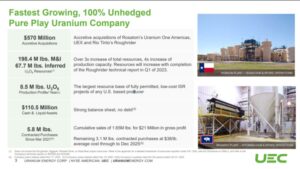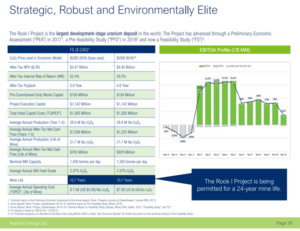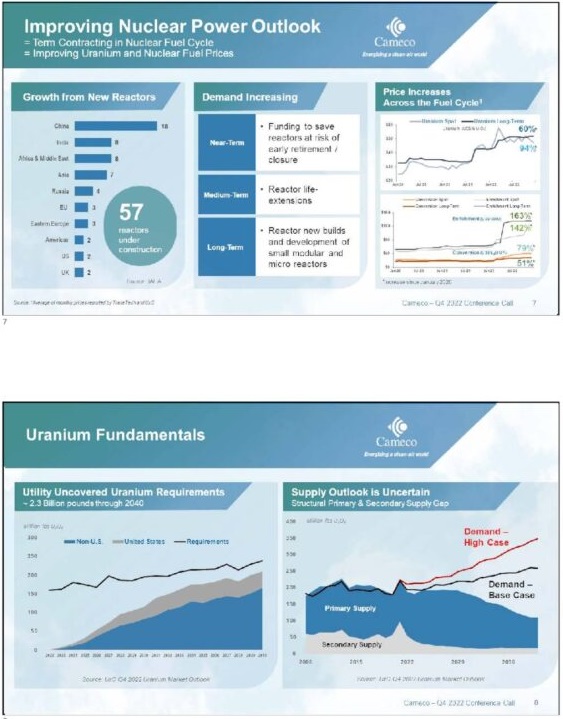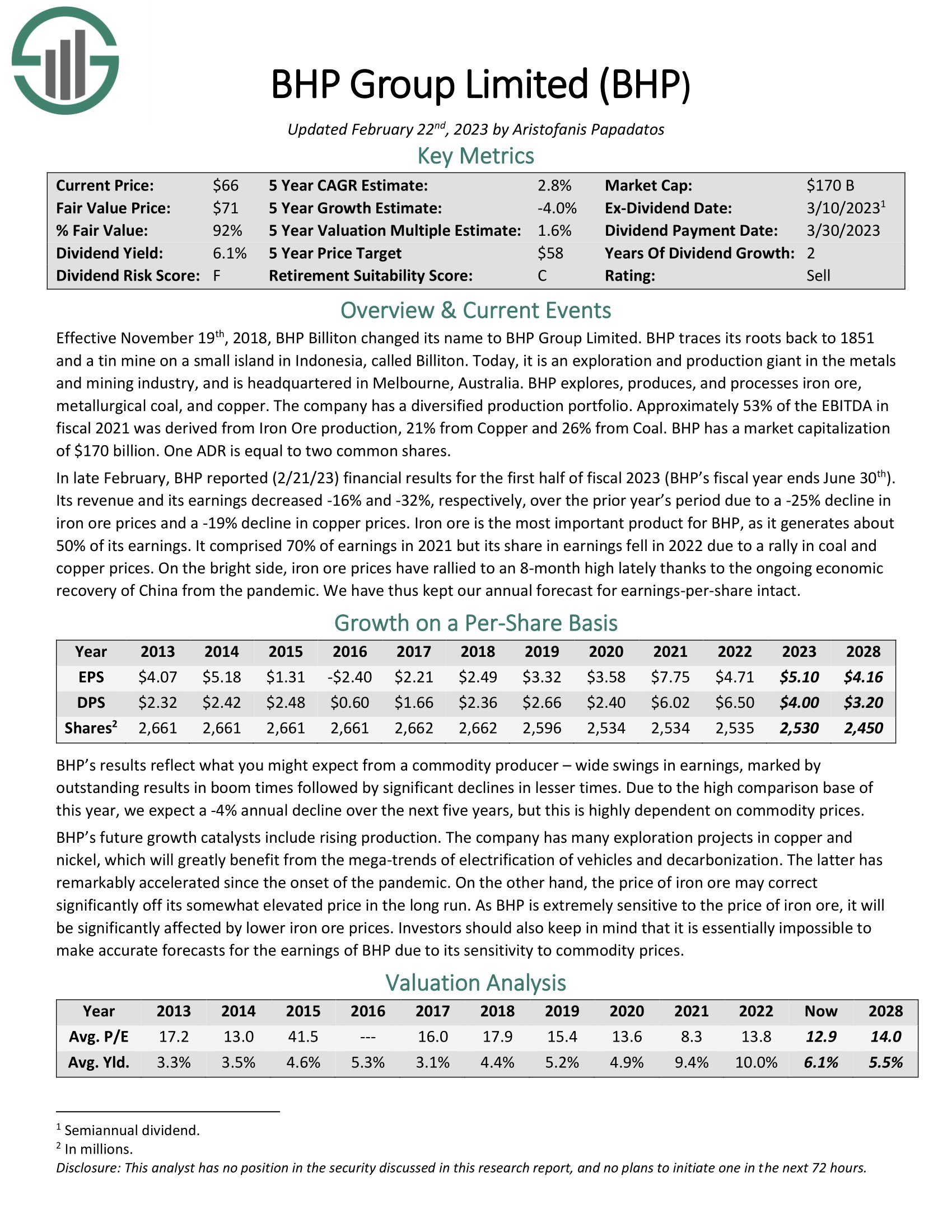First Published on February 28th, 2023 by Aristofanis Papadatos for SureDividend
Uranium plays a pivotal role in producing nuclear power. As a result, investors looking to capitalize on the long-term growth potential of nuclear energy might be interested in learning more about uranium stocks.
Uranium stocks are highly risky–most have low market caps below $1 billion, and only a few pay dividends to shareholders.
However, like many commodities sectors, uranium stocks could provide attractive long-term growth, as demand for nuclear power rises around the world.
With this in mind, we created a list of 40 uranium stocks. You can download a copy of the uranium stocks list (along with important financial metrics such as dividend yields and P/E ratios) by clicking on the link below:

This article will give an overview of the uranium industry, and the top 7 uranium stocks now.
Table of Contents
You can instantly jump to a specific section of the article by clicking on the links below:
- •Industry Overview
- •Uranium Stock #7: Uranium Royalty (UROY)
- •Uranium Stock #6: Ur-Energy (URG)
- •Uranium Stock #5: Energy Fuels (UUUU)
- •Uranium Stock #4: Uranium Energy (UEC)
- •Uranium Stock #3: NexGen Energy (NXE)
- •Uranium Stock #2: Cameco Corp. (CCJ)
- •Uranium Stock #1: BHP Group (BHP)
- •Final Thoughts
Industry Overview
Uranium was discovered in 1789. It is a metallic chemical element, primarily found naturally in soil, rock and water. In the mid-20th century, uranium was found to have potential use as an energy source.
Today, uranium’s primary industrial application is to power commercial nuclear reactors that produce electricity. Uranium is also used to produce isotopes for medical, industrial, and defense.
In 2021, the total global production volume of uranium from mines was 48,332 metric tons. This compares with global production of 54,742 metric tons in 2019.
Kazakhstan is the largest uranium producer in the world, with a production volume of 21,819 metric tons in 2021. This output was down from approximately 22,808 metric tons in 2019.
By contrast, the U.S. produces very little uranium. According to Statista, U.S. uranium production totaled just eight metric tons in 2021. In 2012, production was 1,596 metric tons of uranium in the U.S.
However, the U.S. is the largest consumer of uranium, as nuclear energy use is widespread. In 2020, the U.S. consumed about 18,300 metric tons of uranium, nearly twice as much as the next-highest consumer. After the U.S., the largest consumers of uranium are China and France.
Uranium does not trade on an open market like other commodities. Instead, buyers and sellers negotiate contracts privately. Prices are published by independent market consultants. Recent publications show the price of uranium around $51/pound.
The price of uranium has more than doubled over the past five years, partly due to geopolitical issues at Kazakhstan, which is the top global producer, and Russia. The rally of the price of uranium signifies the potential investment case for buying uranium stocks.
Indeed, the growth potential of uranium stocks is clear. First, roughly one-third of the global population lives in “energy poverty”, meaning lack of access to reliable electricity. Next, the world faces the challenge of climate change, making thermal replacement a strategic priority for many developed nations. Electrification of multiple industries that previously relied on coal for energy is a major task.
Not surprisingly, global demand for electricity is expected to rise by 75% from 2020 to 2050, according to the 2021 IEA World Energy Outlook.
This is where uranium stocks come in. The following section will discuss the top 7 uranium stocks today.
Uranium Stock #7: Uranium Royalty (UROY)
Uranium Royalty was incorporated in 2017 and is headquartered in Vancouver, Canada. It operates as a pure-play uranium royalty company. It acquires, accumulates, and manages a portfolio of geographically diversified uranium interests.
Uranium Royalty has royalty interests in Canada, Arizona, Wyoming, New Mexico, South Dakota and Colorado as well as a project in Namibia.

The geographical diversification of Uranium Royalty may lead some investors to think that the company is somewhat resilient to the cycles of its business. However, this is far from true. The company has posted operating losses every year since its formation. It also has a small market capitalization, which currently stands at $242 million and increases the risk of the stock even further.
Due to the losses and the high risk of Uranium Royalty, its stock price is markedly volatile. Even worse, despite the rally of uranium prices over the last 12 months, the stock has slumped 42% during this period. Overall, the stock is highly speculative and suitable only for the investors who have great conviction in higher uranium prices in the near future.
Uranium Stock #6: Ur-Energy (URG)
Ur-Energy engages in the acquisition, exploration, development, and operation of uranium mineral properties. The company holds interests in 12 projects located in the U.S. Its flagship property is the Lost Creek project, which comprises a total of approximately 1,800 unpatented mining claims and three Wyoming mineral leases that cover an area of approximately 48,000 acres located in the Great Divide Basin, Wyoming. Ur-Energy, which has a market capitalization of only $289 million, was founded in 2004 and is headquartered in Littleton, Colorado.
The Lost Creek project, which is the flagship project of the company, has been in operation for the past 10 years but its production slumped close to zero in recent years due to low uranium prices.

However, thanks to a rally of uranium prices, Ur-Energy has begun to ramp up its production, towards its target annual production rate of 1.2 Mlbs of U3O8.
On the other hand, investors should be aware of the high risk of this small-cap stock. The company recently announced a secondary offering, which triggered a plunge of the stock to a nearly 2-year low level. Overall, Ur-Energy is extremely sensitive to the price of uranium. It is thus a high-risk (at low uranium prices), high-reward (at high uranium prices) bet on uranium prices.
Uranium Stock #5: Energy Fuels (UUUU)
Energy Fuels engages in the extraction, recovery, exploration, and sale of conventional and in situ uranium recovery in the U.S. The company owns and operates the Nichols Ranch project, the Jane Dough property, and the Hank project located in Wyoming; and the Alta Mesa project located in Texas, as well as White Mesa Mill in Utah. It also holds interests in uranium and uranium/vanadium properties and projects in various stages of exploration, permitting, and evaluation. The company was formerly known as Volcanic Metals Exploration and changed its name to Energy Fuels in 2006.
Energy Fuels has a high-value product line, which includes uranium, rare earths, vanadium and other products.

These products are used in numerous applications and enjoy secular growth of demand. Nevertheless, the core product of Energy Fuels is uranium. This helps explain the ticker of the stock.
Just like most uranium companies, Energy Fuels has incurred operating losses in every single year over the last decade, primarily due to low uranium prices. However, thanks to the rally of uranium prices, the company is expected to become profitable this year, with a material profit per share of about $0.55. On the other hand, income-oriented investors should be aware that Energy Fuels is far from initiating a dividend, primarily due to the volatile nature of its business.
Uranium Stock #4: Uranium Energy (UEC)
Uranium Energy engages in the exploration, pre-extraction, extraction, and processing of uranium and titanium concentrates in the U.S., Canada, and Paraguay. The company was formerly known as Carlin Gold and changed its name to Uranium Energy in early 2005. Uranium Energy was incorporated in 2003 and is based in Corpus Christi, Texas.
Uranium Energy has focused its property acquisition program primarily in the southwestern U.S. states of Texas, Wyoming, New Mexico, Arizona and Colorado. This region has historically been the most concentrated area for uranium mining in the U.S. With the use of historical exploration databases, Uranium Energy has been able to target properties for acquisition that have already been the subject of significant exploration and development by senior energy companies in the past.
Uranium Energy does not hedge its production and hence it can reap the full benefit from the rally of uranium prices.

In addition, thanks to its promising growth projects and its rock-solid balance sheet, it has significant upside potential while it can endure patiently the downturns of its business.
Uranium Stock #3: NexGen Energy (NXE)
NexGen Energy is an exploration and development stage company engaged in the acquisition, exploration and evaluation and development of uranium properties in Canada. The company was incorporated in 2011 and currently has a market capitalization of $2.0 billion.
NexGen, like most uranium stocks, is highly speculative. As an exploration and development stage company, the company does not have revenues and has reported operating losses for at least 10 consecutive years. To that end, as of the end of the 2022 fourth quarter, NexGen had equity of only $336 million.
Therefore, investing in NexGen is essentially a bet on the company’s assets. To be sure, the company does possess quality uranium assets. A notable example is the company’s Rook I Project, the largest development-stage uranium project in Canada.

The company has a relatively strong balance sheet with cash of $104 million and total liabilities of only $73 million, as of the end of the 2022 fourth quarter.
Investors interested in safety or stability should not buy the stock. Only the most risk-tolerant investors looking for exposure to uranium stocks should consider NexGen.
That said, the stock could provide attractive returns, in the form of capital gains, if it is able to execute on its growth initiatives.
Uranium Stock #2: Cameco Corp. (CCJ)
Cameco is one of the largest uranium producers in the world. It has the licensed capacity to produce more than 53 million pounds (100% basis) of uranium concentrates annually, backed by more than 464 million pounds of proven and probable mineral reserves.
It is also a supplier of uranium refining, conversion and fuel manufacturing services. Its land holdings, including exploration, span about 2 million acres of land.
Cameco has a dominant position in the largest uranium mine in the world, McArthur River, and is ideally positioned to take advantage of the growing demand for uranium amid limited supply.

In 2022, the company greatly benefited from favorable uranium prices and grew its revenues 27% over the prior year. It also enhanced its adjusted earnings per share from $0.06 in 2021 to $0.09 in 2022.
Thanks to positive business momentum, Cameco expects to grow its revenues to $2.12-$2.27 billion in 2023, much higher than the consensus of $1.72 billion. At the mid-point, this guidance implies 18% growth over the prior year. Moreover, the company is expected to more than double its earnings per share this year, from $0.25 to $0.67.
Cameco stock pays a dividend. However, this dividend is negligible for the shareholders, as the current yield is standing at 0.3%. Therefore, Cameco stock is more of a potential growth stock than a dividend stock.
Uranium Stock #1: BHP Group (BHP)
Uranium stocks are highly risky and can be volatile. As a result, the top spot goes to BHP Group. While BHP is not the largest uranium producer in the world, it offers investors the biggest scale and relative stability. BHP is a global giant with a market cap of $152 billion.
BHP is headquartered in Melbourne, Australia. The company has a diversified production portfolio. It explores, produces, and processes iron ore, metallurgical coal, copper, and more. Almost two-thirds of the company’s annual EBITDA is derived from Iron Ore production, but it is also involved in uranium.
BHP produced approximately 2.4 million metric tons of uranium in the most recent fiscal year, which ended on June 30, 2022. This marked a decrease from 3.3 million metric tons of uranium in 2021, but still makes BHP a major uranium producer.
In late February, BHP reported (2/21/23) financial results for the first half of fiscal 2023. Its revenue and its earnings decreased 16% and 32%, respectively, over the prior year’s period due to a 25% decline in iron ore prices and a 19% decline in copper prices. Iron ore is the most important product for BHP, as it generates about 50% of its earnings. It comprised 70% of earnings in 2021 but its share in earnings fell in 2022 due to a rally in coal and copper prices. On the bright side, iron ore prices have rallied to an 8-month high lately thanks to the ongoing economic recovery of China from the pandemic.
In addition to its size and competitive advantages, BHP is the top pick because it has the highest dividend yield of all uranium stocks.
With a dividend yield above 6%, BHP is a high dividend stock.
Click here to download our most recent Sure Analysis report on BHP (preview of page 1 of 3 shown below):

Final Thoughts
Uranium stocks are risky, and investors should carefully weigh the various risk factors before buying uranium stocks. Many uranium stocks are small companies with uncertain futures. Extremely few uranium stocks pay dividends to shareholders.
However, for investors willing to take the risk, the long-term potential could be rewarding. Uranium stocks are set to benefit from continued long-term growth of nuclear energy around the world. Therefore, the top uranium stocks could generate attractive returns over the long run.
This article was first published by Aristofanis Papadatos for Sure Dividend
Sure dividend helps individual investors build high-quality dividend growth portfolios for the long run. The goal is financial freedom through an investment portfolio that pays rising dividend income over time. To this end, Sure Dividend provides a great deal of free information.
Related:
Dividend Kings in Focus: Walmart Inc.
All 110 Baker Brothers Portfolio Stocks | Current 2023 Holdings





